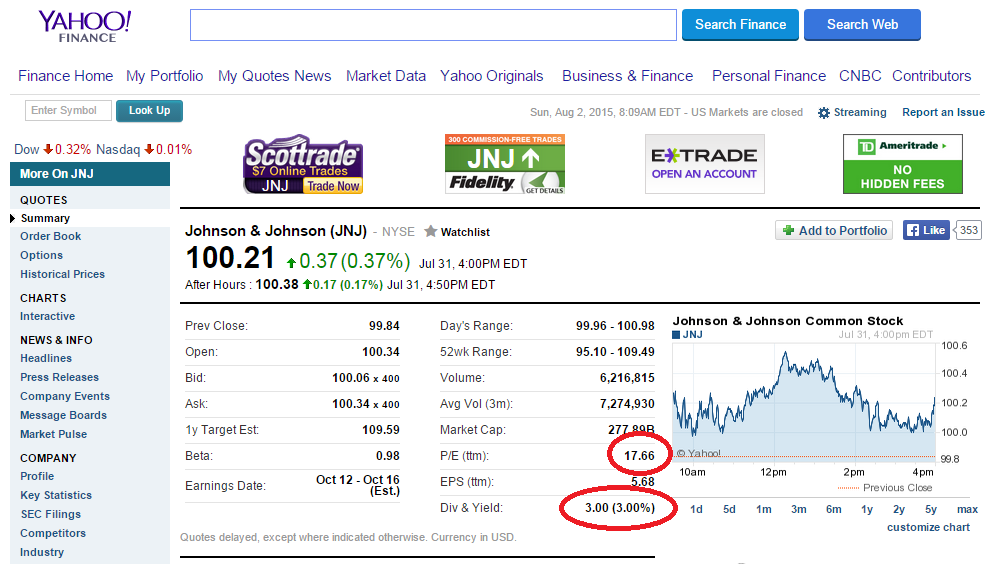
Are you interested in an easy and sure-fire ways to create a steady stream of truly passive income?
Then you need to know about investing in dividend-paying stocks.
Investing in these hidden gems couldn’t be easier. Literally – you don’t have to do anything to earn the money except own the stock! How simple is that?
But before you can own them, you have to learn the right way to invest in dividend stocks if you want to take advantage of the rewards they bring.
Table of Contents
How to Invest in Dividend Stocks
Just like any type of security, there are good and bad dividend stocks to purchase. In this post, we’ll talk about how you can screen the various dividend stocks and select the best ones for your passive income portfolio.
After that, I’ll share how and where you should purchase your dividend-paying stock shares.
Believe it or not, you can start building a dividend stock portfolio no matter what your income. But in case you’re just starting out in dividend stocks, let’s start with some basics.
What is a Dividend Stock?
So, what exactly is a dividend stock?
A dividend stock is a type of common stock that periodically pays its shareholders (i.e. you) a small payment; usually every quarter (3 months).
These quarterly payments are exactly how you can make some extra money right away from owning these stocks.
Where does the money for these dividend payments come from? Generally it comes from the profits that the company has generated.
Think of dividend payments as a way for the company to reward its shareholders for investing and believing in the company.
This will be a very important detail to remember as you’re doing your research. Why? Because as you research you will come across many companies that seem to offer high dividend payments despite making little or even no profits.
Be Wary of Investing in Companies that Seem Shaky
If that’s the case, it could be a red-flag warning that the company is having financial trouble. They could be trying to inflate their dividend yield in an attempt to attract new shareholders.
While there might be some possible short-term gain to be had, use caution with these types of companies. A company that doesn’t make profits won’t be able to sustain very high (or any) dividend payments for very long.
Another “Don’t” for Dividend Stocks
Another common mistake for dividend stock investors is to be too sector-heavy.
In other words, don’t buy all of your dividend stock shares in the energy industry. Instead, buy some in energy, some in manufacturing, some in food, etc.
As with all investing, diversification is vital to overall financial health. As the old saying goes, don’t keep all your eggs in one basket.
How to Research Dividend Stocks:
There are many different ways to research dividend paying stocks before you invest in them. For example, a quick Google search will quickly put you into contact with a number of blogs and websites ran by dividend stock enthusiasts.
Personally I like to invest in relatively safe and stable companies. For that reason, the first two places I look are at the stocks that compromise the major indices: The S&P 500 and the Dow Jones Industrial Average.
You can easily punch in the ticker symbol into your favorite stock screener website and get all the details you’ll ever need about the company and its finances. My favorite ones to use are CNN Money and Yahoo Finance.
Here are some things you’ll want to look for to see if the stock is a good opportunity or not:
Dividend Yield
This metric is a comparison of the dividend payment divided by the price of the stock. Stocks with yields between 3 and 5% are considered pretty high (but not too high that you should be concerned).
Dividend Payout Ratio
The dividend payout ratio is a metric is a comparison of the amount of dividends per share against earnings per share.
For example, a ratio of 100% would indicate that the company is turning all of its profits into dividend payments.
That type of scenario would be in instable and couldn’t continue for very long. Generally stocks in the 30 to 70% range are normal. However this will vary depending on the type of industry the stock is in.
PE Ratio (Price to Earnings Ratio)
The PE Ratio is a classic stock metric that compares the market price against earnings.
A stock’s PE Ratio is determined by dividing a company’s current stock price by its EPS (earnings per share). Generally stocks with lower PE Ratios are thought to be better opportunities.
This is because generally, the lower the PE Ratio, the quicker a company will be able to earn enough money to buy back its share.
Lower PE Ratios don’t always guarantee a smart stock purchase, but they are one factor. Therefore price should be considered as you decide which stocks to purchase.
You might be wondering at this point “Well, what is a good P/E ratio then?”
That’s a great question. As you can see from the example below, the PE Ratio for Johnson & Johnson at this time was 17.66.
According to Investopedia, the current average market PE Ratio hovers around 20 to 25.
This is a good metric to consider when deciding which dividend stocks to purchase.
There are many other metrics you could consider. Every stock enthusiast in the world has their own opinions about what other metrics you should watch out for.
Which Dividend Stocks Should You Choose?
A quick shortcut I like to use to keep my risk modest is to select good blue chip dividend stocks from two famous groups called the Dogs of the Dow and The Dividend Aristocrats.
The Dogs of the Dow are the top 10 stocks among the 30 stocks in the Dow Industrial Average with the highest dividend yields.
Some people like to invest in this group because a high dividend yield indicates the price is likely below market average and a good opportunity.
The Dividend Aristocrats are a group of companies that have not decreased their dividend payouts in over 25 years; despite any financial hardships or market conditions (like bull markets or recessions).
Imagine that – steady and increasing dividend payments for over 25 years despite the market price of the stock itself!
The dividend stocks you choose to buy is solely at your discretion. You might be a risk-taker that wants to take advantage of bargain basement purchases.
Or, like me, you might prefer to stick with proven dividend-paying companies such as:
- Coca Cola
- 3M
- IBM
- Unilever
- Caterpillar (CAT)
- AT&T
- Exxon
- Pepsi
- Pfizer
- Chevron
- Intel
- Proctor & Gamble
You get the picture. These are companies that have been strong for decades, and will likely continue to be strong.
Purchasing Your Dividend Stocks:
Once you’ve got your list of purchases together, the last step to investing in dividend stocks is by far the easiest one:
Go to your favorite discount, online broker (I use Fidelity), setup and fund your account, and then start making your purchases!
The online discount brokers are nice because they’ve set up easy, do-it-yourself systems – AND they charge less in fees than traditional brokerage firms do.
Bonus: You can buy shares in blue chip stock mutual funds with many of these brokerages too.
That’s really all there is to it.
A lot of people think that buying stocks is more complicated than that – as if you have to make several trades per day or time the market.
But truthfully it is a much simpler process than that. Just make sure your funds are ready to go and then make your purchase.
Once I purchase my dividend stocks, I like to give them at least a year before I make any changes to the portfolio.
This is mostly due to tax reasons. In the U.S., if you hold a stock for less than a year, then it counts as a short-term capital gain and will be taxed at a higher rate.
By waiting over a year to sell the stock (if I choose to do so), the stock then becomes a long-term capital gain and gets taxed at a lower rate and can be calculated using a taxcaster’s tool.
As time goes on and you begin to receive dividend payments, the money will passively collect in your core brokerage account. You can decide if you’d like to withdraw these dividend payments or use them to make future stock purchases.
One cool thing most online brokers will let you do with your dividend income payments is to setup a DRIP (dividend reinvestment plan).
What this does is automatically take your dividend payments and use them to purchase more shares of the same stock.
The advantage is that you can usually do this at no cost and you can purchase fractions of shares instead of whole ones.
If you don’t need the money right away, it’s a pretty great way to build your portfolio up even faster, thanks to the power of compound interest!
Summary
Buying dividend stock shares is a great way to build a passive income portfolio. Whether you reinvest the paid dividends to build your portfolio, or take them as regular income, they’re a surefire way to add growth to your financial picture as a whole.
Do you invest in dividend stocks? What are your favorite choices? If you don’t, are you planning on adding them to your portfolio at some point?
Images courtesy of FreeDigitalPhotos.net





